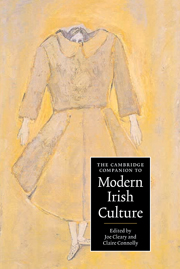Book contents
- Frontmatter
- 1 Introduction: Ireland and modernity
- Part I Cultural politics
- 2 The survival of the Union
- 3 Language, ideology and national identity
- 4 Religion, identity, state and society
- 5 Republicanism, Nationalism and Unionism
- 6 Irish feminism
- 7 Migration and diaspora
- 8 The cultural effects of the Famine
- Part II Cultural practices and cultural forms
- Index
7 - Migration and diaspora
from Part I - Cultural politics
Published online by Cambridge University Press: 28 May 2006
- Frontmatter
- 1 Introduction: Ireland and modernity
- Part I Cultural politics
- 2 The survival of the Union
- 3 Language, ideology and national identity
- 4 Religion, identity, state and society
- 5 Republicanism, Nationalism and Unionism
- 6 Irish feminism
- 7 Migration and diaspora
- 8 The cultural effects of the Famine
- Part II Cultural practices and cultural forms
- Index
Summary
Introduction
Irish migration in the nineteenth century is one of the most significant movements of population in modern European history, in terms of the total number of people involved and the proportion migrating. Between 1801 and 1921 (the period of Union with Britain), approximately 8 million people left Ireland. Ireland's contribution to the outflow of approximately 44 million people from Europe between 1821 and 1914 was the largest of any other country, relative to the size of the island's population. In the twentieth century, outward migration continued; but it was marked by two periods of very heavy out-migration, the 1950s and the second half of the 1980s, and by two periods of net inward migration, the 1970s and the second half of the 1990s. These patterns reached a point in Ireland such that, for all but the eldest son and sometimes daughter, emigration was a life event as 'normal' as leaving school or getting married. Altogether in the period 1949-89 800,000 people left Ireland. There are two consequences following this sustained emigration over the past two centuries. One is that at any one time a significant proportion of people alive who were born in Ireland were living abroad. The second is that there are many millions of people across the globe who are of Irish descent and who can claim an Irish heritage and identity should they so wish.
- Type
- Chapter
- Information
- The Cambridge Companion to Modern Irish Culture , pp. 117 - 136Publisher: Cambridge University PressPrint publication year: 2005
- 5
- Cited by



